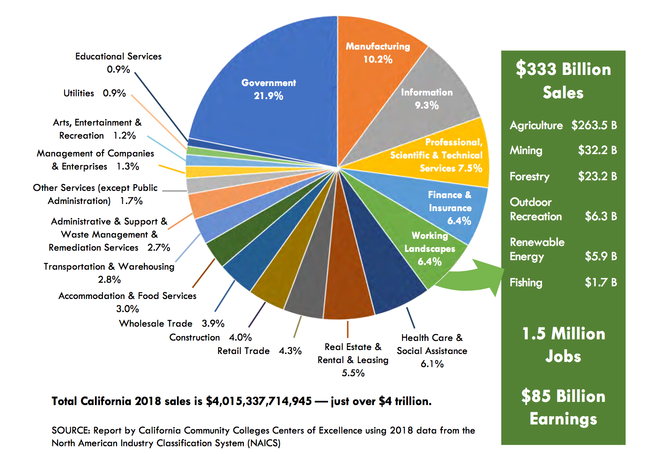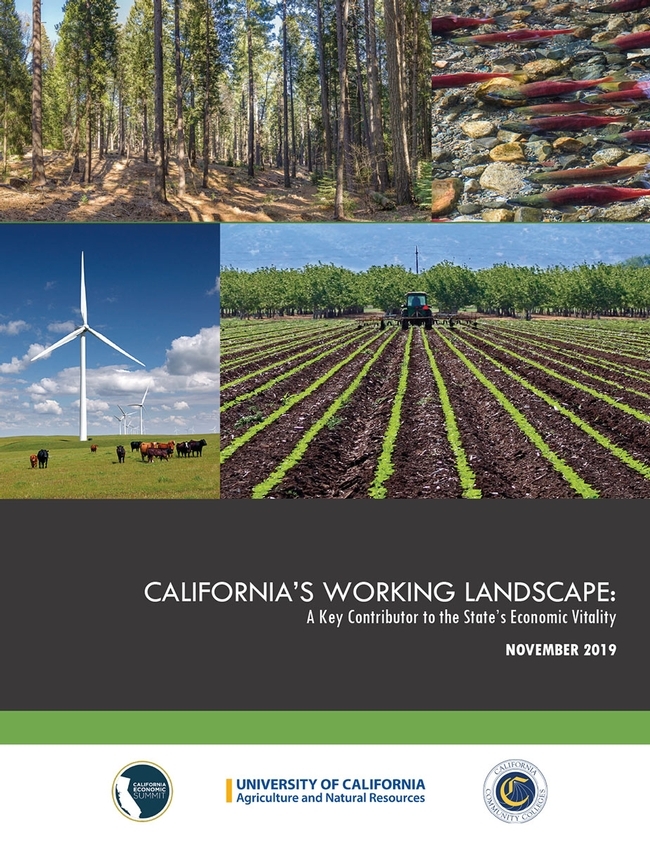New report reveals California’s working landscape is a major economic driver
California's working landscape and the industries associated with agriculture and natural resources are the sixth largest sector of the state's economy, according to a new study by the California Community Colleges Centers of Excellence for Labor Market Research, California Economic Summit and UC ANR.
“When people think of California's economy, they think of entertainment, information technology and other industries. They may not think of the working landscape,” said VP Glenda Humiston. “People may be surprised to learn that California's working landscape accounts for 6.4% of the state's economy, supports more than 1.5 million jobs and generates $333 billion in sales.”
“California's Working Landscape: A Key Contributor to the State's Economic Vitality” was released Nov. 7 by Humiston and Karen Ross, California Department of Food and Agriculture secretary, at the 2019 California Economic Summit in Fresno. More than 900 public, private and civic leaders from across California attended the summit which focused on workforce development, education, housing, infrastructure and ecosystem vitality, with an emphasis on lifting economic growth in all regions of the state.
“I'm excited about this report because it could have policy implications,” Humiston said. “We hope policymakers will understand they need to invest in working landscapes.”
To measure the economic impact of the working landscape, researchers analyzed federal data associated with employment, earnings and sales income of the nine segments that are essential to the working landscape: agricultural distribution, agricultural production, agricultural processing, agricultural support, fishing, forestry, mining, outdoor recreation and renewable energy.
Their analysis of 2018 data from the North American Industry Classification System showed the leading economic drivers were government (21.9%), manufacturing (10.2%), information (9.3%), professional, scientific and technical services (7.5%), and finance and insurance (6.4%). Working landscape ranked a close sixth with 6.4%.
Humiston noted that the estimate value for working landscape is conservative because it doesn't include veterinary services (because researchers couldn't separate livestock from pets) or any retail sales from food in California's 152,000+ supermarkets and convenience stores. It also does not include value of ecosystem services from working landscapes that have indirect economic benefits such as sequestering carbon, capturing water, providing wildlife habitat and offering scenic venues for recreational activities.
The researchers found the nearly 70,000 businesses associated with the working landscape paid $85 billion to workers in 2018 and generated $333 billion in sales income. In terms of job numbers, earnings, sales income and number of establishments, four segments dominate: agricultural distribution, agricultural production, agricultural processing and agricultural support.
In 2018, agricultural production provided the greatest number of jobs, more than 325,000, and generated the second highest sales income, $61 billion.
“I hope everyone reads the report,” Humiston said. “Too many people in this state take for granted where their food comes from and, I think, that has affected ANR funding and our ability to get the support that we need. They also take for granted the infrastructure that makes food safe, nutritious and available, and one of the most important parts of that infrastructure is UC Cooperative Extension because we keep the safety, productivity and other aspects of food production moving forward.”
To read the report “California's Working Landscape: A Key Contributor to the State's Economic Vitality,” visit http://ucanr.edu/WorkingLandscape. A one-page executive summary is available at http://bit.ly/2WTA7Vz.


